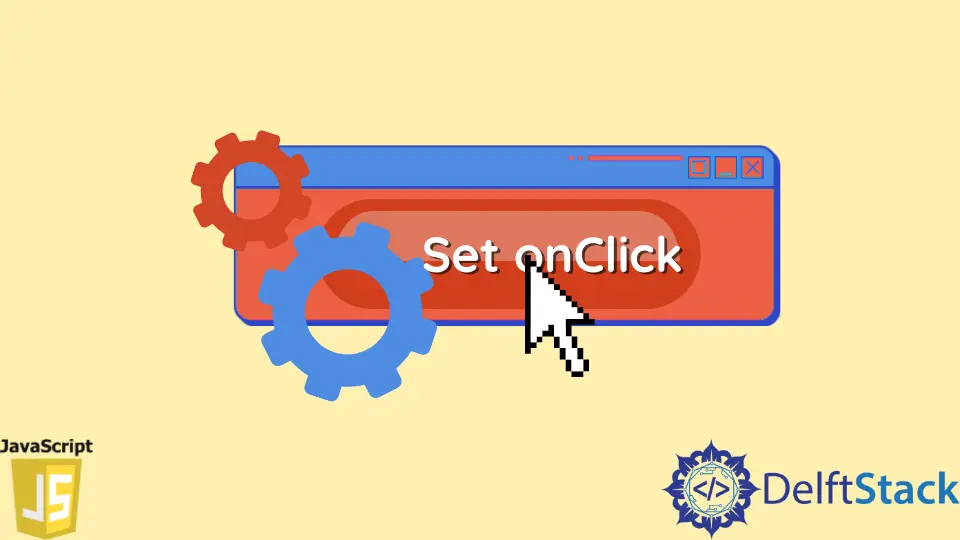How to Set onClick With JavaScript
- What Is an Event and EventListener in JavaScript
-
How to Add an
onClickEventListener to an Element in JavaScript -
How to Pass a Reference of an Element to an
onClickEventListener in JavaScript -
How to Add
onClickEventListener to Jquery in JavaScript

In this tutorial, we will discuss how to attach an onClick listener to an element using JavaScript; we will discuss:
- What is an Event and EventListener or EventHandler in JavaScript
- How to add an
onClickEventListener to an element - How to pass a reference to an
onClickEventListener - How to add
onClickEventListener using Jquery
What Is an Event and EventListener in JavaScript
An event is something that a browser or an end-user does. These events can be handled by a JavaScript concept called Event Handlers or Event Listeners. An Event Listener is executed when a particular event happens.
onClick is one of these Event Listeners. An onClick event listener triggers/executes when a user clicks on an element.
How to Add an onClick EventListener to an Element in JavaScript
<!DOCTYPE html>
<html>
<body>
<div id="textElement" onclick="ChangeColor()">
Change Color to Red
</div>
<script>
function ChangeColor() {
document.getElementById("textElement").style.color = "red";
}
</script>
</body>
</html>
The above code would trigger/execute the ChangeColor method, which will access the element, using the Document object model, having an id of textElement and changing its text color to red.
Notice that the onClick is set as a property of an element in HTML similar to class, id, etc.
Alternatively, you can set the attribute onClick of an element directly using JavaScript.
<!DOCTYPE html>
<html>
<body>
<div id="textElement">
Change Color to Red
</div>
<script>
document.getElementById("textElement").onclick = function() {
document.getElementById("textElement").style.color = "red";
};
</script>
</body>
</html>
This will access the textElement and assign it a function; this function will execute when the user clicks the HTML element, the result will be similar. For example, the element’s color having an id of textElement would be changed to red.
Furthermore, you can use the addEventListener method/function of the JavaScript element to perform the same functionality.
<!DOCTYPE html>
<html>
<body>
<div id="textElement">
Change Color to Red
</div>
<script>
let element = document.getElementById("textElement");
element.addEventListener("click", function(){
element.style.color = "red";
});
</script>
</body>
</html>
The addEventListener takes two arguments; the first is the type of event to listen to on an HTML element, and the second is the callback function that would execute when a certain event occurs.
If you are using Internet Explorer, the addEventListener will not work because of compatibility issues. We would have to use a fall-back using attachEvent to replicate this behavior.
<!DOCTYPE html>
<html>
<body>
<div id="textElement">
Change Color to Red
</div>
<script>
let element = document.getElementById("textElement");
if(element.addEventListener){
element.addEventListener('click', function(){
element.style.color = "red";
});
}else if(element.attachEvent){
element.attachEvent('onclick', function(){
element.style.color = "red";
});
}
</script>
</body>
</html>
How to Pass a Reference of an Element to an onClick EventListener in JavaScript
<!DOCTYPE html>
<html>
<body>
<div id="textElement" onclick="ChangeColor(this,'red')">
Change Color to passed Color
</div>
<script>
function ChangeColor(element,color) {
element.style.color = color;
}
</script>
</body>
</html>
In the example, we pass two arguments, this and red, this passes a reference to a DOM element to the function, whereas red is just a string.
You can notice that by just changing the second argument, we can change the element’s color. This approach increases reusability compared to the other approach. For example, we can use the ChangeColor method with multiple elements.
<!DOCTYPE html>
<html>
<body>
<div id="textElement" onclick="ChangeColor(this,'red')">
Change Color to Red
</div>
<div id="textElement" onclick="ChangeColor(this,'blue')">
Change Color to Blue
</div>
<script>
function ChangeColor(element,color) {
element.style.color = color;
}
</script>
</body>
</html>
How to Add onClick EventListener to Jquery in JavaScript
If you are not using Vanilla JavaScript but are using something like Jquery, a JavaScript library, the process is similar; the only difference is the Syntax.
<!DOCTYPE html>
<html>
<head>
<script src="https://ajax.googleapis.com/ajax/libs/jquery/3.5.1/jquery.min.js">
</script>
<script>
$(document).ready(function(){
$("#textElement").click(function(){
$(this).css('color','red')
});
});
</script>
</head>
<body>
<div id="textElement">Change Color to Red</p>
</body>
</html>
It will add an event listener to the element having an id of textElement as soon as the document loads.
Related Article - JavaScript EventListener
- How to Change Input Value in JavaScript
- How to addEventListener vs. Onclick in JavaScript
- How to Check Whether a Button Is Clicked by JavaScript